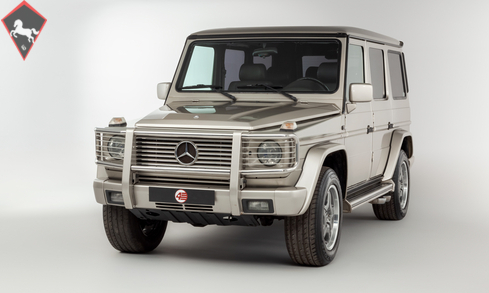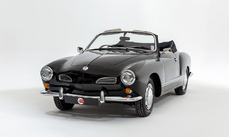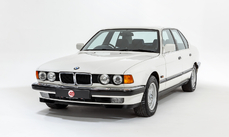Mercedes-Benz Geländewagen AMG 1997
Allgemeine Beschreibung :
Model History
The Mercedes-Benz G-Class, sometimes called the G-Wagen (short for Geländewagen – meaning “terrain vehicle”), is characterised by its boxy styling and body-on-frame construction. It uses three fully-locking differentials and is one of the few production vehicles to have such a feature. Despite the introduction of an intended replacement in 2006, the GL-Class, the G-Class remains in production to this day and is one of the longest produced vehicles in Daimler's history, with a span of 40 years – only the Unimog surpasses it.
Development of the G-Class started in 1972 with a cooperative agreement between Daimler-Benz and Steyr-Daimler-Puch in Graz, Austria. Mercedes-Benz engineers in Stuttgart were in charge of design and testing, while the team in Graz developed the production plans. Construction commenced in Graz, where the new cross-country vehicle would be assembled nearly entirely by hand in 1975, with production of the “G Model” beginning in Graz in 1979.
The first major refinements were introduced in 1981. These included an automatic transmission, air conditioning, an auxiliary fuel tank, protective headlamp grilles, and a cable winch. Fuel injection became available in 1982, when the 230GE was introduced in Turin, along with more comfortable and supportive front seats, auxiliary heating, wider tires and flared arches. For 1985, differential locks, central door locking, and a tachometer became standard, and by 1986 over 50,000 G models had been produced.
For 1990, the G-Class (W460/W461 chassis) was extensively revised, and a new chassis number – W463 – was assigned. The W463 moved the G-Class from a solely utilitarian vehicle to the luxury model we know today. Resultantly, no three-door panel vans or “barn door” variants were offered for W463; those features were exclusive to the W461.
The 1990 facelift included several exterior revisions for a more modern aesthetic. These features included a smoother front end with body-coloured headlamp bezels and grille, a form-fitted front bumper with integrated fog lamps, body-coloured wheel arch flares, the addition of a fuel filler flap, and revised rear lights. The interior was also significantly updated with wood trim and could be specified with leather upholstery for the first time. The centre console was smoothened out and better integrated with the dashboard, the electric differential lock switches were placed prominently in the middle of dash, and the instrument cluster met the dashboard more fluidly. The climate control panel was also revised to include the temperature and fan speed dials, and the seats were plusher with several defined cushions and lumbar support.
Equipment
Smoke Silver Metallic paintwork, Black leather upholstery, 4-speed automatic transmission, 16-inch AMG alloy wheels, 4-wheel drive, Air conditioning, Electric sunroof, Heated and electrically-adjustable front seats, Electric windows, Electric door mirrors, Burred walnut interior trim, Individual front armrests, CD player, Body-coloured exterior trim, Body-coloured spare wheel cover, Side steps, Front fog lights, Bull bar, AMG badging, AMG side exit exhaust.
Exterior
Sporting colour-coded bumpers, wheel arch flares, mirror casings, side steps and rubbing strips, this long-wheelbase G36 really looks the part. The Smoke Silver paintwork retains a deep and uniform shine throughout and, while a few small blisters have begun to show through in a handful of places, the overall appearance is very presentable indeed. The bumpers front and rear are without any major scrapes or scuffs, and the car is nice and straight along both sides.
VIEWINGS WELCOME BY APPOINTMENT ONLY /// ADDITIONAL PHOTOS AVAILABLE UPON REQUEST
Interior
The interior boasts full black leather upholstery, all in superb condition throughout. The front seats are heated and electrically-adjustable and further benefit from individual folding armrests, again both in superb order. Other commonly worn items such as the steering wheel and gear selector show few signs of wear, and glancing across the dash you’ll find glossy walnut trim and switchgear that still feels reassuringly solid to operate. The carpets are also in excellent unworn condition and are protected in the footwells by a set of genuine Mercedes mats. The rear seats are in equally fine order and the vast boot area is also very tidy.
ENGINE & TRANSMISSION
The 3.6-litre M104 straight six starts first turn of the key and idles up to temperature without fuss. It’s paired with a four-speed automatic transmission that’s still very smooth on test, handling the engine’s power perfectly through the gears. On arrival from Japan earlier this year the car was treated to a full service and general shakedown in preparation for sale, the invoice for this work alone totalling in excess of £3,900. The car further benefits from a new air mass sensor, alternator, catalytic converter, and advisory-free MOT valid until October 2022.
WHEELS, TYRES & BRAKES
The G36 sits on 16-inch AMG alloy wheels with a very smart two-tone paint finish and absolutely no curb marking to speak of; they are shod in Toyo Proxes tyres all round, each one with ample tread left. The brakes have also been checked and remain in fine operational condition having received new pads and shoes less than 100 miles ago.
History File
This rare example was supplied new to its first keeper in Japan in January 1997. Originally leaving Germany as a 320 GE, the car was later converted to a G36 by AMG in Japan, as shown by the additional AMG VIN plate in the door shut. While German-made AMGs could be imported directly into Japan, AMG also had their own facility in Japan where stock Mercedes vehicles could be modified under license of AMG.
After landing in the UK earlier this year with all taxes paid on arrival, this LHD example was fully inspected and re-commissioned as necessary. The current owner has now spent in excess of £6,000 mechanically preparing the car for sale, as documented in the accompanying paperwork. Recent work includes a full engine service, gearbox service, brake overhaul, a new air mass sensor, cat, alternator, battery, etc. Since arriving with us the car has been inspected once again and boasts a clean bill of health.
Inside the History File there is a leather AMG document wallet with all owner handbooks, a raft of Japanese maintenance documents, UK invoices totalling £6,098.51, and a fresh inspection report from our trusted classic car specialists. UK registration is currently underway.
http://www.4starclassics.com/for-sale/mercedes-g36-amg-for-sale/
1997 Mercedes-Benz Geländewagen AMG is listed verkauft on ClassicDigest in Kingsley by 4 Star Classics for £34995.
Fakten der Auto
Karosserietyp : Auto Marke : Mercedes-Benz Modell : Geländewagen Ausführung : AMG Hubraum : 3.6 Modelljahr : 1997 Karosstyp : Pick up Lage : Hampshire
Verkauft
Angaben Zum Verkäufer
Verkauft
People who viewed this Mercedes-Benz Geländewagen also viewed similar Mercedes-Benz listed at ClassicDigest
Other cars listed for sale by this dealer
über Mercedes-Benz
In den Annalen der Automobilgeschichte entfaltet sich die Reise von Mercedes-Benz wie eine Erzählung voller Ingeniosität seiner Gründer. Im Jahr 1886 schuf Karl Benz den Benz Patent Motorwagen, eine Kreation, die als das weltweit erste Automobil in die Geschichte eingehen sollte. Unwissentlich markierte dieser Moment den Ursprung dessen, was sich zu einem weltweit renommierten Premium-Autohersteller entwickeln würde. Die finanzielle Basis dieses bahnbrechenden Unternehmens wurde interessanterweise von Karls Ehefrau, Bertha Benz, bereitgestellt, was eine bemerkenswerte Partnerschaft demonstrierte, die den Ton für das Erbe von Mercedes-Benz setzen sollte.Nicht weit entfernt entstand eine parallele Erzählung, als die Daimler-Motoren-Gesellschaft, gegründet von Gottlieb Daimler und Wilhelm Maybach, die Bühne betrat. Im Jahr 1901 enthüllten sie ihr Auto unter dem mittlerweile berühmten Namen "Mercedes", was auf Spanisch "Geschenk Gottes" bedeutet. Dieser Name wurde auf das Auto auf Wunsch von Emil Jellineks Tochter verliehen, dem Vertriebspartner der Daimler-Motoren-Gesellschaft. Die Räder der Innovation wurden in Bewegung gesetzt.
Springen wir vorwärts ins Jahr 1926, ein entscheidendes Jahr, das die Fusion von Daimler mit Benz & Cie. sah, was zur Geburt von Daimler-Benz führte. Die Fusion führte zur Übernahme von "Mercedes-Benz" als das renommierte Markenzeichen für ihre Automobile und verschmolz die Legenden zweier visionärer Unternehmen zu einer.
Entgegen konservativen Wahrnehmungen entfaltet sich die Geschichte von Daimler-Benz als Chronik von Branchenneuheiten. Von der Einführung des Wabenkühlers über den Schwimmervergaser bis zur bahnbrechenden Einführung von Vierradbremsen im Jahr 1924 trieb Daimler-Benz kontinuierlich die Grenzen der automobilen Innovation voran. Der Dieselantrieb des Mercedes-Benz 260 D im Jahr 1936 markierte den Beginn von Dieselmotoren in Personenkraftwagen. Der ikonische Mercedes-Benz 300SL Gullwing schrieb Geschichte als das erste Auto mit direkter Kraftstoffeinspritzung, wenn auch der winzige 2-Takt-Motor des Gutbrod Vorrang beanspruchen kann.
Sicherheitsinnovationen wurden zum Markenzeichen, mit Béla Barényis patentiertem Sicherheitszellen-Design in den "Ponton"-Modellen im Jahr 1951, das Front- und Heck-Knautschzonen umfasste. Der W116 450SEL 6.9 führte die Einführung des Antiblockiersystems (ABS) ein, eine weitere wegweisende Sicherheitsfunktion. Vom ersten serienmäßigen Airbag bis hin zu vielen weiteren Innovationen wurde das Erbe der "Ersten" weiter in das Gewebe von Daimler-Benz eingeschrieben.
Auf seiner über hundertjährigen Reise hat Mercedes-Benz nicht nur Autos produziert, sondern automobile Ikonen geschaffen. Der SSKL, 710 SSK Trossi Roadster, 770K Grosser, 540K Spezial Roadster, 300SL Gullwing, W100 600 Pullman, W111 280SE 3.5 Flachkühler, W113 230SL Pagode, W109 300 SEL 6.3 und W201 2.3-16 Cosworth sind Zeugnisse des Engagements der Marke für Ingenieurkunst.
Die donnernden Silberpfeile, oder "Silberpfeile", darunter der W 25, W 125, W154, W165 und W196, schufen ein Erbe der Dominanz auf der Rennstrecke. Diese Maschinen waren nicht nur Autos; sie waren Ausdruck von Präzision, Geschwindigkeit und einem unbezwingbaren Geist, der die Konkurrenz im Staub zurückließ.
Während Mercedes-Benz in die Zukunft schreitet, tut es dies nicht nur als Automobilhersteller, sondern als Hüter eines Erbes, als Fackelträger der Innovation und als Leuchtturm automobiler Exzellenz. Der Weg in die Zukunft wird zweifellos die Fortsetzung der Verschmelzung von modernster Technologie, zeitlosem Design und dem unerschütterlichen Engagement für die Festlegung neuer Standards in der Welt der Automobile erleben.

























